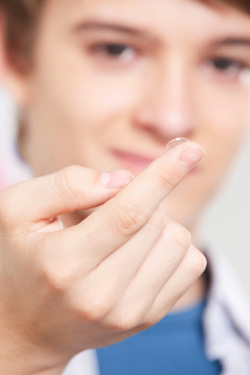Mom, Can I Get Contact Lenses, Please?

by U.S. Food and Drug Administration
Between Harry Potter and the rise of “geek” culture, lots of kids today consider wearing eyeglasses fashionable, and even downright “cool.” Still, the day may come when your son or daughter comes to you and asks for contact lenses.
There are some good reasons to say “yes,” and there are also reasons to say “no.”
According to Bernard Lepri, O.D., M.S., M.Ed., an optometrist at the Food and Drug Administration (FDA), contact lenses have benefits. “They can be better for sports activities, because they don’t break as frames and the lenses of glasses can, and they provide better peripheral vision for sports, or driving, if your teen is of driving age,” Lepri says. Moreover, in some cases, contact lenses improve the quality of vision in comparison to eyeglasses, especially when a child is very nearsighted, says Lepri.
Contact lenses can provide benefits beyond improving vision. A three-year study conducted at the Ohio State University College of Optometry (October, 2007) on children between the ages of 8 and 11 showed a definite improvement in a child’s self perception when wearing contact lenses as opposed to glasses, especially for girls.
On the other hand, “You have to remember that contact lenses are medical devices, not cosmetics,” Lepri says. “Like any medical device, contact lenses should be used only if they can be used safely and responsibly. And only under the supervision of your eye care professional.” Serious injury to the eye can result particularly if the contact lenses are not removed at the first hint of a problem.
No One Wants a Visit to the E.R.
Kids and contact lenses are not always the best fit.
According to a 2010 study published in Pediatrics, about 13,500 or one fourth of the roughly more than 70,000 children who go to the emergency room each year for injuries and complications from medical devices are related to contact lenses. The problems from contact lenses include infections and eye abrasions.
The reasons? Hygiene and responsibility. Or rather, Lepri says, the lack thereof.
He adds that it’s essential for all people who wear contact lenses to follow their eye care professional’s advice “to the letter.” That means observing basic hygienic precautions, such as:
- Always wash your hands before cleaning or inserting lenses, and carefully dry your hands with a clean, lint-free cloth.
- Rub, rinse, and disinfect rinse your contact lenses as directed and only with the products and solutions recommended by your eye care professional.
- Avoid keeping lenses in too long.
- Never put a contact lens into an eye that is red.
- Never wear someone else’s lenses.
- Don’t ignore eye itching, burning, irritation or redness that could signal potentially dangerous infection. Remove the lenses and contact your eye care professional.
- Apply cosmetics after inserting lenses, and remove your lenses before removing makeup.
Not taking the necessary safety precautions can result in ulcers of the cornea (the front of the eye that shields it from germs, dust, and other harmful material) and even blindness. “Even an experienced lens wearer can scratch a cornea while putting in or taking out a lens,” Lepri says.
What About Young Kids and Contacts?
“Eye care professionals typically don’t recommend contacts for kids until they are 12 or 13, because the risks are often greater than the benefits for younger children,” Lepri says.
But, he adds, age isn’t the only issue—it’s also a question of maturity. Lepri suggests that parents who are considering contacts for their kids take a look at how well they handle other responsibilities, especially personal hygiene. “It takes vigilance on the part of the parents,” he says. “You need to constantly be looking over your child’s shoulder.”
As many an eye care professional can attest, kids find all sorts of ways to be less than hygienic. Common behaviors include wearing another child’s lens, using saliva to moisten a lens, and wearing decorative lenses purchased from flea markets, beauty supply stores, the Internet and other sources. Even a lens without corrective power is still a medical device and has all the risks other contact lenses do, says Lepri.
Extended wear lenses are generally not recommended by eye care professionals for kids and teens and can increase the incidence of corneal ulcers, which can lead to permanent loss of vision. Although a bit more expensive, daily disposable lenses can reduce some of the risks since the wearer is using a new pair of lenses every day.
Children with seasonal allergies are usually not good candidates for wearing contact lenses. The lenses may only increase the itching and burning caused by their allergies.
More Tips for Safe Lens Wearing
Other tips include:
- Don’t sleep with your contact lenses in unless they are specifically approved for overnight use, says Lepri. Overnight use of daily wear lenses dramatically increases the risk of corneal ulcer, even with just one night’s wear.
- When playing sports, wear safety goggles or glasses over your lenses.
- Always have a pair of back-up glasses handy.
“It’s easy to impress upon kids the dangers of unsafe driving,” Lepri says. But the potential perils of contact lens wearing are harder to get across. “Kids think they’re invincible,” he adds. “They just don’t think anything bad is going to happen to them.”
ww.FDA.gov – U.S. Food and Drug Administration, Protecting and Promoting Your Health.




